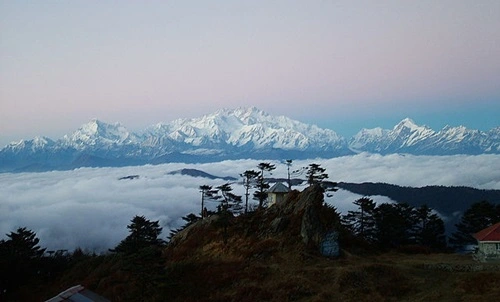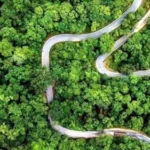Sandakphu, the highest peak in West Bengal, offers an unparalleled adventure for trekking enthusiasts and nature lovers. Towering at an altitude of 3,636 meters (11,930 feet), Sandakphu is known for its breathtaking views of four of the five highest peaks in the world – Everest, Kanchenjunga, Lhotse, and Makalu. It’s a destination that attracts trekkers from all over the world, thanks to its unique vantage points, diverse flora and fauna, and the thrilling challenge of the trek itself. But when is the best time to visit Sandakphu?
The answer depends on what kind of experience you’re after. Each season brings a different charm to the Sandakphu trek, whether it’s blooming rhododendrons, clear mountain views, or the snow-draped trails of winter. Here’s a breakdown of the best seasons to visit, and what you can expect from each.

March to May: Springtime in the Himalayas
Temperature Range: 8°C to 15°C
Why Visit? Blooming rhododendrons, pleasant weather, vibrant landscapes
Spring, from March to May, is one of the most enchanting times to visit Sandakphu. The temperature during this period ranges from 8°C to 15°C, providing pleasant conditions for trekking. Springtime offers clear skies, moderate temperatures, and the added beauty of blooming rhododendrons and magnolias. As you trek through the Singalila Ridge, you’ll find the landscape covered in vibrant colors, with pink and red rhododendron blossoms carpeting the trail.
In addition to the floral display, the visibility during spring is often excellent, offering stunning views of the Himalayan peaks. Kanchenjunga, also known as the “Sleeping Buddha” due to its distinct formation, is particularly striking during this season. For trekkers who want to experience both natural beauty and comfortable weather, spring is an ideal time to visit Sandakphu.
October to December: Autumn’s Clear Views and Crisp Air
Temperature Range: 5°C to 12°C
Why Visit? Crystal-clear mountain views, mild cold weather, ideal for photography
Autumn, from October to December, is widely considered the best season to visit Sandakphu. After the monsoon rains have cleared, the skies are often free of clouds, providing crystal-clear views of the Himalayan range. The temperature during this time ranges between 5°C and 12°C, making it comfortably cool during the day and chilly at night. For those who prioritize clear mountain views, this is the ideal season.
During autumn, the landscapes are stark yet beautiful, with unobstructed views of the snow-capped peaks, including the towering Everest and Kanchenjunga ranges. This is also an excellent time for photographers, as the clarity of the atmosphere enhances the grandeur of the mountains, making it easier to capture those iconic shots.
Due to the popularity of this season, trekkers can expect a moderate number of fellow travelers on the trail, creating a sense of camaraderie without the overcrowding typical of more accessible trekking routes.
January to February: The Winter Wonderland
Temperature Range: -5°C to 5°C
Why Visit? Snow-covered trails, solitude, challenging trek
For those who want a truly adventurous experience, the winter months of January and February offer a challenging yet rewarding trek through snow-covered trails. The temperatures can drop as low as -5°C, with daytime temperatures staying between 0°C and 5°C. Winter is not the easiest season for trekking to Sandakphu, as the trails can be icy and the paths are often covered in snow, requiring proper gear and physical endurance.
However, the reward for those who brave the cold is a serene, almost mystical experience. The landscapes are blanketed in snow, adding an ethereal beauty to the surroundings. Fewer trekkers visit Sandakphu during winter, which means that you’ll have the trail mostly to yourself, allowing for a quiet, introspective experience.
The visibility of the peaks is generally good in winter, though the views may occasionally be obstructed by mist. For those who seek solitude, unspoiled snow-covered vistas, and a unique adventure, winter is an unforgettable time to experience Sandakphu.
June to September: The Monsoon Season
Temperature Range: 10°C to 20°C
Why Visit? Lush greenery, fewer tourists, a different perspective on the trail
The monsoon season, spanning from June to September, is a time when most trekkers avoid Sandakphu due to heavy rainfall, slippery trails, and low visibility. However, if you’re an adventurous soul and don’t mind trekking in the rain, this season offers a unique perspective on the trail. The entire region comes alive with lush greenery, and the forests are at their most vibrant.
While mountain views are often obscured by clouds and mist, the forests and meadows become a sight to behold, with numerous wildflowers blooming. This season is also perfect for solitude seekers, as fewer people attempt the trek, giving you a more private experience with nature. Just remember to bring adequate rain gear and be prepared for muddy, challenging paths.
Planning Your Sandakphu Trek
The Sandakphu trek is not just about the destination; the journey through the Singalila National Park is equally rewarding. To make the most of your experience, here are some practical tips:
- Permits: The Sandakphu trek requires permits, as it passes through Singalila National Park. Make sure you obtain them beforehand from the forest office in Maneybhanjang, the trek’s starting point.
- Accommodation: Basic lodges and homestays are available along the trek route, especially in places like Tumling, Kalapokhri, and Sandakphu. These provide basic amenities, but booking ahead during peak seasons is advised.
- Guides and Porters: Hiring a guide or porter is highly recommended, especially for those unfamiliar with high-altitude treks. Guides are mandatory in the national park and can enhance your experience with insights into the region’s flora and fauna.
- Packing Essentials: Regardless of the season, it’s essential to carry warm clothing, a good sleeping bag, and proper trekking boots. In winter, bring additional layers and snow gear, while in the monsoon, waterproof clothing and sturdy rain covers for your backpack are crucial.
- Altitude Sickness: Sandakphu’s altitude is significant, so be mindful of altitude sickness. Acclimatize well, keep hydrated, and avoid pushing yourself too hard.
Conclusion
Each season offers a distinct Sandakphu experience, catering to different types of trekkers and travelers. Whether you’re drawn by the lush blooms of spring, the clear skies of autumn, the snow-clad silence of winter, or the refreshing green landscapes of the monsoon, Sandakphu’s beauty is mesmerizing year-round.
So, lace up your boots, pack your essentials, and embark on an unforgettable journey to Sandakphu. This trek promises not only remarkable views but also a connection with the raw, untouched beauty of the Himalayas. Whether it’s your first trek or a seasoned venture, Sandakphu will leave you with memories to cherish forever.


